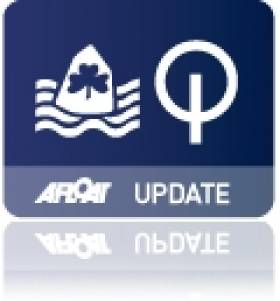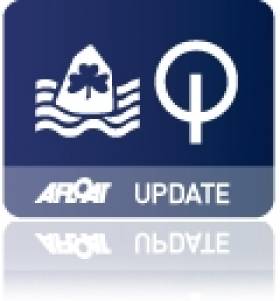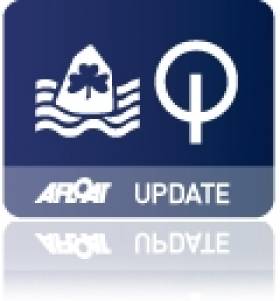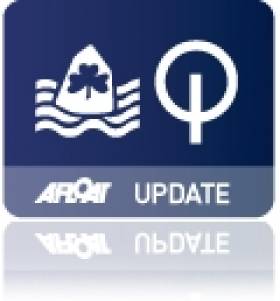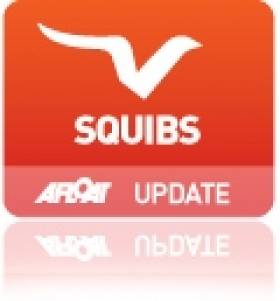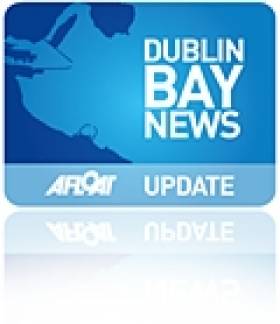Displaying items by tag: Royal St George Yacht Club
'Ar Nós Na Gaoithe' – Optimist Championship Competitors from 44 Countries Try Out Irish
#OppyEuros2014 – After two days of competition, 255 Optimist sailors from 44 nations are getting used to the wind and the waves of Dublin Bay but what about the local lingo? The enterprising videographers at the Royal St. George Yacht Club asked a few of the Under–16 competitors to get their mouth's around the Irish phrase Ar Nós Na Gaoithe [as fast as the wind]. Just like the sailing, there were varying degrees of success!
Racing in the final qualification rounds continues on Dublin Bay this morning with two more races before the fleets are split into gold, silver and bronze.
Winds on the bay are light enough at 5 knots as the boys fleet of 153 boats begin to launch.
Irish Team Drop Back at Dublin Bay Optimist Europeans
#OppiEuros2014 – Irish boys could not maintain their two top-20 rankings in today's second day of competition at the Optimst European Championships on Dublin Bay where there have been dramatic changes in positions at the Royal St. George hosted event.
The winds were marginally lighter but it may also be that our visitors have quickly learned how to sail Dublin Bay.
However James McCann of Royal Cork Yacht Club now in 26th place and Loghlen Rickard of the National Yacht Club in Dun Laoghaire (NYC) in 51st have an excellent chance of making the cut to the Gold Fleet (top third for boys, top half for girls) following tomorrow's racing when the worst single race result is discarded.
The new leader of the boys' event is Kasper Nordenram of Rörviks Sailing Club (on a lake in central Sweden). Competition at the top of the fleet has grown very close with Kasper leading from Enzo Balanger from Guadeloupe, sailing for France, and Pablo Lujan of C.N. Javea, Spain.
Overnight leader Jacob Ahlers had a poor third race but bounced back to place 4th in the fourth race of the day and may benefit when the first discard is taken, as may reigning champion Tytus Butowski of Poland.
In the girls' event the Irish had mixed fortunes. Clare Gorman who had been 16th after the first day slipped back to 32nd. However Gemma McDowell (Malahide Yacht Club), Dara Donnelly (NYC) and Sarah Cudmore (Royal Cork Yacht Club) all improved their rankings and now also lie in top 60 of the 101 boat fleet.
Iset Segura from the Catalan club of Arenys de Mar leads with a win in Race 3 and a lead of 20 points over the overnight leader Josefine Akesson (Sweden). Brazilian Olivia Belda and Ebru Bolat of Romania are next, within a point of each other.
However the rather lighter winds today had a significant effect on the overnight results lower down the fleet. Reigning champion Mara Turín of Slovenia who had disappointed on day one registered two 6th places and others who may have benefited include the Asian girls such as Lisa Nukui (Japan) (scores 1 and 8) and Shyn Ee Phua (Singapore, 7 & 8).
The best results of the day came from the British girl Fenella Bennett (Royal Lymington Yacht Club) with two second places. She commented "It took a while to come to terms with the waves on Dublin Bay but now I found that sailing slightly less close to the wind pays off".
With good races tomorrow they will have an excellent chance of making the cut for the gold fleet. This will take place after tomorrow's racing when the half of the fleet with the best five results from the six races will form the gold fleet.
#OptiEuros2014 – Ireland has got off to an exceptional start at the massive 254–boat Optimist European Championships on Dublin Bay this afternoon.
Exceeding expectations of top half results, the top Irish under–16 sailors are placed tenth and 17th in the 153 boat boys' fleet after the first two races where winds gusted over 20–knots.
James McCann of Royal Cork Yacht Club scored seventh in both races with team-mate Loghlen Rickard of the National Yacht Club (NYC) scoring eight & ten.
In the 101 boat girls fleet, Clare Gorman (NYC) lies 16th after scoring 12 and seven. Alix Buckley of Skerries scored a superb second in her opening race and currently lies 40th.
The boys' event after two races is being led by 2013 German national champion Jacob Ahlers from MSC Hamburg followed by, in the open ranklist, Iagor Franco of Brazil and Campbell Patton of Bermuda.
In 4th and 5th (2nd and 3rd in the European closed event) are Elias Odrischinsky (POL) and another German Lennart Kuss.
Defending champion Tytus Butowski (POL) started his championship well with a fourth place. He showed great boat–speed both up-and down-wind and could have won except for a conviction that the left was the favoured side of both beats. His second race was less successful, placing 17th.
In the girls' event Josefine Åkesson of Sweden leads from Iset Segura of Spain and Senef Seder (TUR).
Results here
#oppieeuros2014 – Young sailors from 44 countries attended the formal opening of the European open championship of the Under-16 Optimist sailing class at Dun Laoghaire, County Dublin today.
The 253 youth sailors with their coaches and team leaders walked in a colourful procession from the Royal Marine Hotel where most of them are staying to the Town Hall where they were greeted by An Cathaoirleach Marie Baker. Eamon Gilmore T.D. spoke of the importance of sailing to the local economy and Frank O'Beirne, chairman of the organising committee of the future of lifetime sailing for the young participants.
The sailors then processed to the club where a welcoming speech was given by Liam O'Rourke, commodore of the Royal St. George with a reply by Lady Stanley of Alderley, vice-president for Europe of the International Optimist Dinghy Association. The official event flag was raised by Grace O'Beirne, one of the 14-sailor Irish team.
Many of the teams will have been encouraged by the presence of the ambassadors of their countries, those from Argentina, Austria, Belgium, Brazil, Bulgaria, Canada, Denmark, France, Great Britain, India, Netherlands, Norway, Romania and the deputy chef de mission of Russia.
These are just a few of the countries represented, 32 of them from Europe where each country may enter seven sailors including three of each gender, and 12 from non-European nations who can enter four.
The Optimist Dinghy's Good News Story Sails Into Dublin Bay
#OppiEuros2014 – This weekend sees a truly international sailing event taking shape in Dun Laoghaire, with the Optimist European Open Championship attracting 250 young sailors from 44 nations (32 European, 12 others). They will take to the waters of Dublin Bay in a little boat which is one of the key strands in the fabric of world sailing. W M Nixon takes a look at the Opty back-story, and outlines the front runners in the Euros and the home team.
Once upon a time, there was an American magazine called The Saturday Evening Post, which lived up to its name by arriving in millions of households across America in the last postal delivery of each week. It provided a focus for family life with its homely mixture of entertaining, informative and educational articles. And as it was the most widely circulated weekly in America, it had the resources to employ talented artists who each week evocatively illustrated the very best of American life with a strong family slant.
But it's a long time now since the demand for post and printed material were such that a publication of this quality could be a viable proposition. The Saturday Evening Post ceased to be a weekly in 1963, and for a while was reduced to a quarterly. These days, it is published six times a year as an exercise in nostalgia by The Saturday Evening Post Society. But while it may now only be a shadow of its former self, the weekly illustrations produced at its height by its team of artists have endured as highly-regarded works of art in themselves. And nothing more perfectly captured the essence of American home and small town life at its very best than the paintings of Norman Rockwell who, in a 50 year career with the magazine, created more than 300 of The Saturday Evening Post's distinctive covers. It was popular art at its very best.
Yet even an all-embracing magazine of this calibre could not cover every good news story going on in America during its glory years from 1920 to 1960, and there were some gems which escaped Rockwell's technically brilliant attention. So if there's ever a competition to create The Greatest Norman Rockwell Picture Never Painted, let us suggest that "Building The First Optimist Dinghy in Clearwater, Florida" should be right up there for consideration. Indeed, as the International Optimist Dinghy Association is such a thriving, prosperous and global body, I'd suggest they commission it themselves, as doing so would create a neat story in itself.
"Neat" is the word which most often comes up in talk of the Optimist, and of course in America it carries wider connotations than the simpler European notion of tidiness. At just 8ft long, the little sailing pram is neat but deceptively simple, and the people who brought it into being in Florida in August 1947 were quiet geniuses who did much good work mostly by stealth, but knew when to beat a drum when it suited their cause.
It started with a recently returned World War II veteran, Major Clifford A McKay, noting that while his son Clifford Jnr aged 12 much enjoyed the landbound wheeled soapbox races for young people organized by the Clearwater Optimist Club (one of those classically American community groups like the Rotarians and the Lions), the boy's most strongly developing interest was sailing as a crew in the local Snipe dinghy class.
Back in 1947, even in Florida there wasn't the money to splash about on any sport in which your child showed an interest, so the Major got fired up with the notion of creating the cheapest possible sailing boat – a floating soapbox - that could get the local young people afloat in their own boats. His own interest in boats was purely for fishing, but he proved he could turn his inventive mind to anything, and he outlined his requirements to the local boatbuilder Clark Mills, who happened to be going through a quiet late summer period at his workshop.

Clark Mills (1915-2001), designer and builder of the first Optimist
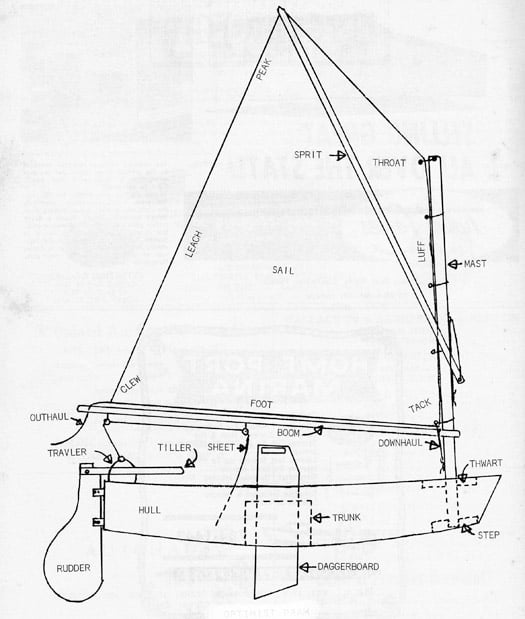
The first drawings for the Optimist – it was to be built with two sheets of 8 x 4 plywood
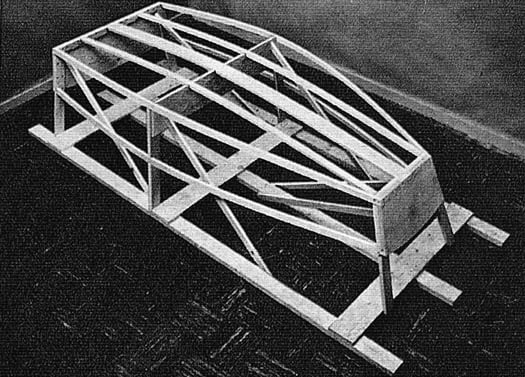
This framework was the mould on which the first Optimists were built by Clark Mills
Within a fortnight, Mills - the quintessential all-American can-do character – had created a bright red 8ft sailing pram, the dimensions dictated by the fact that it was to be made from two sheets of 8ft x 4ft ply, the rig dictated by the utter simplicity of a sprit setup, as they'd hoped to make the sail from a square bedsheet.
The bedsheet was the first notion to be scrapped – the local sailmaker and his wife were soon producing economy sails. But as for the basic design, it was a winner from the start. Yet even in his wildest dreams, young Clifford Mackay Jnr could never have thought, as he sailed that first able little prototype out on Clearwater Bay, that he was sailing a boat which would go on to become a cornerstone of global sailing.
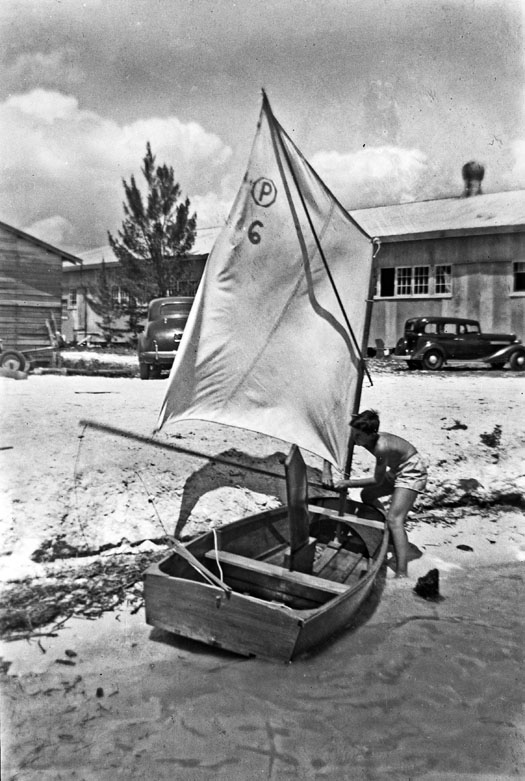
Young Clifford McKay with one of the first Optimists at Clearwater Bay, Florida in 1947
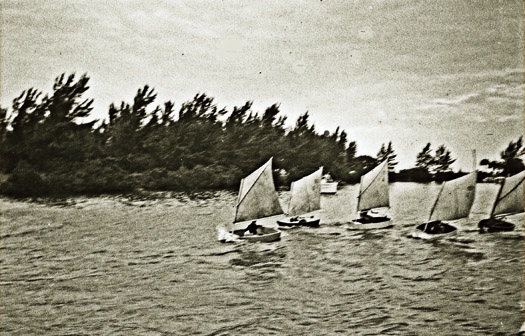
The fleet is racing....thanks to sponsorship from neighbourhood businesses in 1947, the Clearwater Optimist fleet was soon in action
Local needs came first. The class took off in Clearwater when Major McKay and his committee secured sponsorship from neighbourhood firms for the building of 28 boats. That it was all happening outside the stuffy constraints of established sailing became evident when the local paper reported an early series. It simply mentioned that the Optimist prams of the Clearwater Sun and WTAN Radio Station had tied on points. Blatant sponsorship and advertising were anathema to traditional yachting (even if Lipton and Jameson had boosted sakes of their tea and whiskey with sailing success), but the idea that the sponsor would be named but the helmsman ignored went way beyond the pale.
Be that as it may, it worked in getting the show on the road, and the Clark Mills Boat Works was soon churning out Optimists, while Major McKay was successfully promoting the idea throughout Florida. Reaching a wider public didn't dent the little boat's good image in any way - in fact, it enhanced it. Other builders were to find that building a competitive Optimist was in no way as easy as "Clarkie" Mills made it seem, and it was recalled that his Boat Works had produced some super-fast Snipes.
As for Mills himself, he had no doubt his interpretation of McKay's outline had produced something very special, and quipped: "I think I'm the best designer in the United States. I'm damned good. I've got the splinters and the backache to prove it....."
It might have been out of character for him to admit the profound satisfaction that the Optimist's success in opening up the world of boats had given him in his varied life from 1915 to 2001, but he couldn't suppress his love of sailing: "A boat, by God, it's just a gleamin' beautiful creation. And when you pull the sail up on a boat, you've got a little bit of somethin' God-given. Man, it goes bleetin' off like a bird wing, you know, and there's nothin' else like it."
There were other small boats becoming available which were broadly similer to the Optimist in concept, and in Ireland at Skerries local sailor Brian Malone, a naval architect with BIM (the Sea Fisheries Board) created a tiny children's sailing pram dinghy which he called the Measle, as every kid would have it sooner or later. But while the Measles had to be robustly built to cope with Irish conditions, by comparison the Optimists seemed light as a feather, and by the 1950s they were going international in an unexpected direction, having taken off big time in Scandinavia.
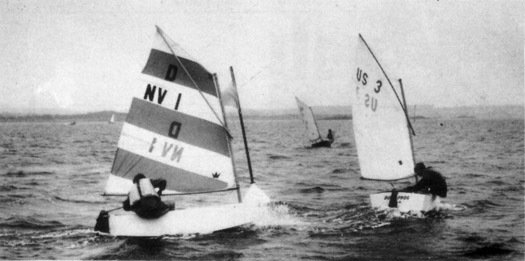
Rapid international expansion began when the Optimist became widely accepted in Scandinavia in the 1950s. By 1967-68, Peter Warren of Denmark (left) was twice world champion, using an Elvstrom sail.
That such a stronghold of classic yacht design should adopt the utilitarian little American boat speaks volumes for the Optimist's versatility, and the fact that at only 8ft, moving the boats around was not a major logistical challenge. Nevertheless some countries held out against the Opties' easy appeal. But by the early 1960s even the traditional strongholds in the south of England were sharing the momentum, and a regatta in the Hamble River in 1962 set the seal on the Optimist's British success, with the first fibreglass boats also starting to appear.

This regatta in the River Hamble in 1962 confirmed the Optimist's growing popularity in England
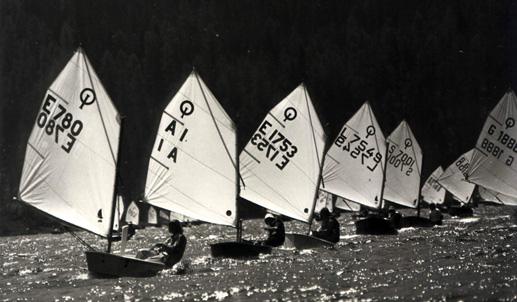
A mighty long way from a creek in Florida – a major Optimist championship under way at St Moritz in Switzerland
Today, practically every sailing family in the world goes through its Optimist phase while there are kids under the age of 15 in the lineup, with the prime years with national and international aspirations being 13-15. Thus the most intense Optimist individual window is only two to three years. In some families, the involvement can be almost total, while in others it's just a case of having an Optimist or two about the place.
We were in this situation for about twelve years in all, and it ended on something of a high with the youngest son showing his entrepreneurial skills by becoming a part-time Opty dealer long before he'd a driving licence. This meant his parents had to drive him to other sailing centres where the class was developing, and then stay in the background while he struck a deal with some nervous parent anxious to provide a hot boat for their demanding child. Major Clifford McKay and Clarkie Mills – you've a lot to answer for........
Ireland has punched way above her weight in Optimist involvement, and the development of the international association has seen key players such as Robert and Helen-Mary Wilkes of Howth, and Curly Morris of Larne, making dedicated input in order to keep the Optimist class relevant to the needs of modern sailing, while Robert Wilkes took time out to record the history of the class in a gem of a book which has provided much of the material for our look at the early years.
Adaptation and innovation have been central to the Optimist's continuing success. Thus although the convenient size of the little boat has been a bonus in times past, even at just 8ft long it is now becoming so expensive to move about internationally that one of the attractions of the Europeans at Dun Laoghaire will be the provision of a large charter fleet already on site.
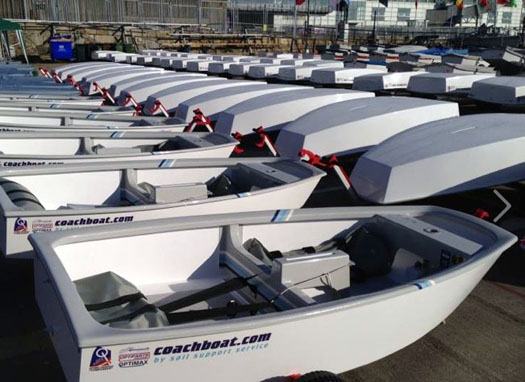
A glimpse of the future – the charter boats which will be used at Dun Laoghaire by a significant number of young sailors
As for the site, Dun Laoghaire has enthusiastically woken up to the fact that it can provide the kind of club and accommodation package which topline modern events expect. The Royal St George Yacht Club is the host, while the Royal Marine and Kingston Hotels have combined forces to provide what is in effect an Olympic village.
If you want the ultimate measure of the Optimist's central role in sailing, it's worth noting that six of the female European Olympic dinghy medallists in London 2012 had participated in Optimist European Championships, the male "graduates" included triple Olympic medalist Iain Percy, and worldwide you'll find that top people in sailing in many different areas of the sport are more than happy to remember their Opty days - it's just part of what our sport is all about.
In the coming days, it's the defending girls' champion, Maria Turin of Slovenia, who'll be the main focus of attention, for if she succeeds, it will make it three in a row. As for the boys, Tytus Butowski of Poland is the defending champion.
So far, Ireland's best result came in 1992 when Laura Dillon of Howth was fourth, while in 2011 Peter McCann (Royal Cork) placed 5th. Like youth itself, there's something essentially ephemeral about top level Optimist racing, but for the year or three that's in it, Ireland's lineup for 2014 is: Sarah Cudmore (Royal Cork), Dara Donnelly (National YC), Gemma McDowell (Malahide YC), Grace O'Beirne (Royal St George YC), Clare Gorman (National YC), Harry Bell (Royal North of Ireland YC), Alex Buckley (Skerries SC), Michael Carroll (Kinsale YC), Loghlen Rickard (National YC), James McCann (RCYC), Alex O'Grady (Howth YC), Daniel Hopkins (HYC), Jamie McMahon (HYC) and Peter Fagan (SSC).
#flyingfifteen – The last of the waterfront clubs summer regatta's took place at the RStGYC on Saturday and the Flying Fifteen class was won by Dave Gorman & Chris Doorly in Betty in testing conditions as the winds were all over the bay. This gives them the 'grand slam' as they won all four waterfront regattas. Second was Ian Mathews with Jonathan O'Rourke helming on the same points as Adrian Cooper & Joe in Gulfstream in a well deserved third place.
It was forecast to be windy from the west, something we havnt had for a while but during racing the prevailing wind was fighting with the sea breeze and the usual hole appeared in the Bay giving a testing time to the competitors and the Race Officers.
In race 1 there was a bias to the pin and there were about 12knots under the big dirty cloud above so full hiking was the order of the day . . for a while at least! O'Rourke/Mathews led the way after a good start at the pin, as the boats tacked onto port there was a shift and a change in wind strength, those on the left were knocked and the two boats that had gone right were coming in full steam with Ken & Maryjane leading at the weather mark from O'Rourke, Justin Maguire and Adrian Cooper, Gorman was fifth to the weather mark. On the reach Gorman sailed low to try and get some place by getting water at the next mark, this worked well and at the gybe mark was second. The wind was holding, O'Rourke went to the right of the second beat along with Adraian while Gorman and Maguire went left, by now the wind was getting lighter and flukier. Maguire & Burgess made big gains and tacked in under O'Rourke at the weather mark but were sailed over, Gorman was fifth. Downwind Gorman went right hoping for that sea breeze and the help of the incoming tide, it looked good for a while as those on the left had no wind Then the wind gods gave those on the left wind and took it from the right! As the boats neared the leeward mark the wind picked up for a few minutes. As Gorman went left on starboard he got tangled with a port Fireball, for the last lap the positions didn't change so O'Rourke won from Justin & Frank with Gorman third and Adrian & Joe fourth.
There was a very long break between races as all classes were given 3 laps, this is preventable if the first couple of classes are given an extra lap. With the winds now more easterly the PRO reset the course, due to the uncertainty it was to be a shorter two lap course- this proved to be an inspired decision!
To have any chance of winning the regatta Gorman had to win and hope O'Rourke and Maguire have a poor race, this was unlikely but you would never know. The Meagher's were also out to add to the mix for the second race after having a lie in! In race 2 the wind was up and the pin end was biased, O'Rourke got the pin, with Colman to his weather, Gorman started away from the pin and managed to trap the two boat below, as in last week regatta there was actually very little time to be on starboard ,Gorman went a little beyond the lay line and O'Rourke and Colman had now overstood the mark and were in Gorman's dirt. As he approached the weather mark the boats from the right were coming in on starboard, Gorman got in about two boat lenghts in front of Alan Dooley and Adrian Cooper with the Cahills close behind. There was a bit of heavy traffic at the weather mark and O'Rourke and Maguire got caught up in it as Gorman increased his lead. On the second beat Dooley was sailing well on the right, the wind had now dropped and anything could happen, Gorman was in the middle but headed slightly right and was relieved to get around the weather mark intact- the rest were not so lucky. It was a beat now on the run, Gorman went left to the forecasted wind from the west and kept moving in the light winds, the beat to the finish was a run. Dooley stayed second with Adrian third, the Cahills fourth and the Meagher's fifth with O'Rourke in sixth place and Maguire behind them. So the regatta was won in difficult conditions where anything could happen and anything did happen.
Once ashore it was down to the RStGYC for the usual regatta festivities and prize giving, the club had a great bbq with super food and live music. Next week its back to the DBSC series.
#squib – A strong Royal North of Ireland contingent took the top three places overall at yesterday's 23–boat Squib keelboat eastern championships at the Royal St. George Yacht Club in Dun Laoghaire. Full results are available to download below. Overall winners were 1996 Olympic helmsman John Driscoll sailing with David Cagney on 6 nett points. Second on ten points was Royal North club mates Gordon Patterson and Ross Nolan with third going to Des Clayton and Paul Henry on 20 points. Local Royal St. George crew Pete Evans and Paul Maguire were next home on 22 points.
As well as Royal North of Ireland visitors came from Killyleagh, Royal Irish Yacht Club, and National Yacht Club.
The first three races were held in approx. 15kts. of cold northerly wind with a big confused sea left over from gales of the previous night.
Race 1 was won by Martin Byrne and Joe O'Byrne in 24, Femme Fatale from Pete Evans and Paul Maguire in 832, Anemos and Peter and Marie Dee in 813 Kookaburra. Remarkably each of these Dublin Bay boats is manned by refugees from the Dragon fleet.
Race 2 was won by Olympian John Driscoll and Dave Cagney in 78, Afficianado from Gordon Patterson and Ross Nolan in Quickstep III with Des Clayton and Paul Henry in 794, Inismara. This result with three northern boats is a carbon copy of the final overall placings.
With crews getting tired in the strenuous conditions, Race 3 was won by Quickstep III followed by Afficianado and Anemos
Overnight the leaders were Quickstep III from Femme Fatale and Inismara on equal points. The Royal St. George put on an enjoyable dinner for all the competitors and their friends and partners.
Sunday dawned with very different conditions, sunshine, fickle winds of between 3-6 knots which progressively swung around from the west to the north. Fortunately the waves had declined from the previous day, so the conditions were more kindly to the lighter crews.
Race 4 was won by light air specialist Frank Whelan 46, in Lola from Afficianado and Kookaburra. After 4 races a discard was applied which was beneficial to Afficianado who had missed the first race (for reasons best known to themselves), and Anemos who were able to drop their OCS.
The final race in a falling wind went to Afficianado from best lady Jill Fleming and Conor O'Leary in 44, Perfection and Quickstep III.
In the final line up it was three Royal North of Ireland boats in the top 3 places.
The fleet will compete again next week in The Northern Championships in Killyleagh.
#rsgyc – The RStGYC May/June Friday Series (open to all comers) for Laser and RS dinghies had another two great races last night writes Heather King. Good to see the increased turnout and we were lucky with a little ridge of higher pressure between a series of lows and by start time the breeze had eased all the way back to a very pleasant 10 knots, blowing out from the direction of Seapoint's Martello Tower.
#rstgyc – Races were rattled off by surely one of the youngest Race Officers Dun Laoghaire has ever seen for adult racing. Adam Hyland, who has represented the George overseas with distinction and topped national rankings in both the 420 and Optimist classes, performed one master-stroke in particular. He noticed he had time pre-start to shift his freshly-laid course 200 yards offshore. He saw fresher breeze and, crucially, big flicks to the left and, had he not relaid, the weather mark would have required a position way South, which would have been a very interesting obstacle course over the West pier !
RSs went off first for 3 rounds W/L and at the first mark the Boys Craig/Foley led in a 200 from Ryan/Murphy in the 400. However, Emmet and Luke in the bigger rig soon showed great speed and downwind angles, allied to slick boathandling, to dominate both races for the rest of the night. Craig/Foley led the 200s home comfortably in race one but were further back in the two lap second race when Clodagh and Adrian Hinkson staged a remarkable comeback on the lead 200 raced by Laser/Fireball ace Justin Maguire. The Hinksons carried a beautiful, soaking downwind course in a softening breeze and, had they not required one final gybe just a few metres from the line, they would surely have pipped Maguire and crew Heather Craig. Downwind finishes sure are interesting !! The other 200 and 400 crews all had their moments in the challenging patchy, shifty conditions.
The Lasers sailed two rounds each time and it was good to see some additional new faces this week in Ross O'Leary, Conor O'Leary and Peter Docherty. Things were competitive, especially when Ross challenged in race One and Conor got well in the mix in race Two. However Patrick Cahill again showed apalling disrespect for his elders, claiming both guns ! This Radial sailor will have no problems at all with the Full rig going forward, that much is clear. It also shows this Friday series is absolutely perfect for younger sailors anywhere close to the transition stage between the smaller Laser rig and the Full. Plus what better way to take a little break from studies on a Friday night ?
Hyland wrapped things up to give his two old sea dog assistants a rest onboard the flagship and things looked decidedly gloomy and dark for 8 o'clock. Sure enough the heavens later opened up but boats were all derigged and pints and burgers were already being guzzled down under cover on the balcony.
We'll welcome more next week for sure as 4 or 5 cyclists were absent, not on the visting Giro D'Italia but away terrifying people with their lycra on the island of Mallorca. Lads, please note the lycra is out on this racetrack, especially "Giro pink". The peloton will no doubt also be boosted by the returning Hugh Sheehy. Expect double figure turnouts in both RSs and Lasers.
Regatta entry here
#squib – The Royal St George Yacht Club hosts the Irish Squib East Coast Championship 2014 from 24-25 May 2014 writes Squib captain Rupert Bowen.
The Dun Laoghaire class welcomes Squib sailors back to the club, which hosted the Irish Squib Nationals in 2012 with 32 entries and the UK Squib Nationals in 2010 with over 70 entries. 15-20 entries for the Easterns this year, although it could be more (32 boats entered the Squib Inlands in Dromineer last October)
The plan is to run five races over the two days and to award prizes after racing concludes on Sunday 25th May.
The Squib is a 6m keelboat that can appeal to a wide range of sailors and levels of experience, age etc. There are active and growing Squib fleets all around Ireland and Great Britain. In the Dublin Bay fleet we have teenagers and retired men and women and all ages in between! We have sailors who have competed at the highest level internationally as well as people who simply enjoy a race "around the cans" in Dublin Bay. We race around the buoys in Dublin Bay on Tuesday, Thursday evenings and around "Olympic" dinghy courses on Saturday afternoons.
#dlmarina – A year after yacht clubs reacted to a cut in Dun Laoghaire Harbour's swinging moorings, the Royal St. George, has vacated it s long held east bight moorings at the request of the Dun Laoghaire harbour Company and relcoated to the town marina.
The harbour company requires the east bight area to facilitate visiting cruise ships, a new area of revenue for the harbour.
The Royal St.George, the country's biggest club, says 'As opposed to doing a partial withdrawal over the 2014/2015 seasons we have agreed a new facility with Dun Laoghaire Marina in their West Bight section'.
It is intended that all Royal St George boats on the East Bight will relocate. Moorings in front of the club house are currently unaffected. The club says it has agreed a very favourable rate with the marina and takes into account the notified increases for mooring charges.
A launch service between the club and the Marina will be available and currently a scheduled service is being drawn up, this will be the only point of access to the West Bight.
The initial agreement between the club and the marina is for a period of 4 years.
The club website advises 'the West Bight berthing rate exclusive to RSGYC members will be €170 p/ meter vs. the Marina's advertised rate of €217.50 p/ meter' This rate is available from Lift In – Lift Out and only to RSGYC members that availed of moorings in the last few years.
For 2013 Royal St.George mooring rates were €147 p/ meter. With the increases from the Harbour Co for 2014 the rate would be in the region of €155 p/ meter, the club estimates.
The west bight marina facility will only be accessible from the RSGYC club house pontoons and will be served by the Launch Service with one pickup/ drop off point on the West Bight which will increase efficiency.




























